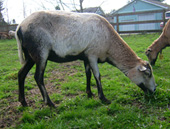






2011 Lambs 2 Ewe lambs remaining Adult Stock Several breeding Contact Tracy for sheep information. Sheep are located in Columbia Falls-MT and Hood River-OR. |
Blackbelly Barbados Sheep
In 1904, the USDA imported a small flock of these sheep to Bethesda, Maryland. This importation probably formed the basis of the Barbados flocks in the United States today. The horned rams, which we prize so highly in the U.S. today, were probably created by the introduction of horned breeds in the U.S. (The rams in the Caribbean are usually polled, although the occasional individual with scurs or horns does occur.) Despite this obvious introduction of other bloodlines, these horned rams are considered the norm and are acceptable for registration. Ewes in both locations are usually polled, but occasional individuals grow small scurs. Blackbellies range in color from light tan to a dark mahogany red, with black breed markings on the face, legs, belly, inguinal region, chin, and chest. Animals presented for registration should not be so dark as to entirely obscure these breed markings. Random spots - especially white - do occur; but they should not be extensive to the point where they challenge breed integrity. Despite their appearance, Blackbelly carcasses are well-muscled. Their long leg bones and almost total lack of carcass fat create the illusion in the live animal of alack of development of hind quarters as compared to shorter-legged early-fattening common commercial breeds. Barbados Blackbellies are very easy care animals, lambing and raising twins (or better!) with ease. The ewes are polyestrous; that is, they readily breed at any time of the year. The lambs are somewhat slower growing than many commercial breeds; but they do not need the volume of high-protein type concentrates used to "finish" such breeds. Barbados are a breed of hair sheep. Hair sheep are NOT the result of a goat/sheep crossbreeding, as is commonly thought, but are a variety of true domestic sheep. All hair sheep are fully fertile in crosses with wooled breeds and are genetically different from goats. Growth of a wooly "undercoat" is stimulated when tropical hair sheep are raised in temperate climates. This undercoat, which is of no real value, is shed naturally in spring and/or subsequent to lambing. Despite their tropical origins, the breed is perfectly comfortable in our northern climate. Excessive non-shedding wooliness is a very likely indication of crossbreeding and is considered undesirable. |
||
| Basquelaine & Intention Hill  Promote Your Page Too |
 |
 |
 |
 There is frequently confusion about the name of this breed. In the United States and Canada, the animals are referred to as "Barbados." On their island of origin, that name seems to be unknown; and the breed is referred to as the "Blackbelly."
Although there can be little doubt that the Barbados Blackbelly has African ancestry, there is compelling evidence that the breed originated and evolved on the Island of Barbados.
There is frequently confusion about the name of this breed. In the United States and Canada, the animals are referred to as "Barbados." On their island of origin, that name seems to be unknown; and the breed is referred to as the "Blackbelly."
Although there can be little doubt that the Barbados Blackbelly has African ancestry, there is compelling evidence that the breed originated and evolved on the Island of Barbados.